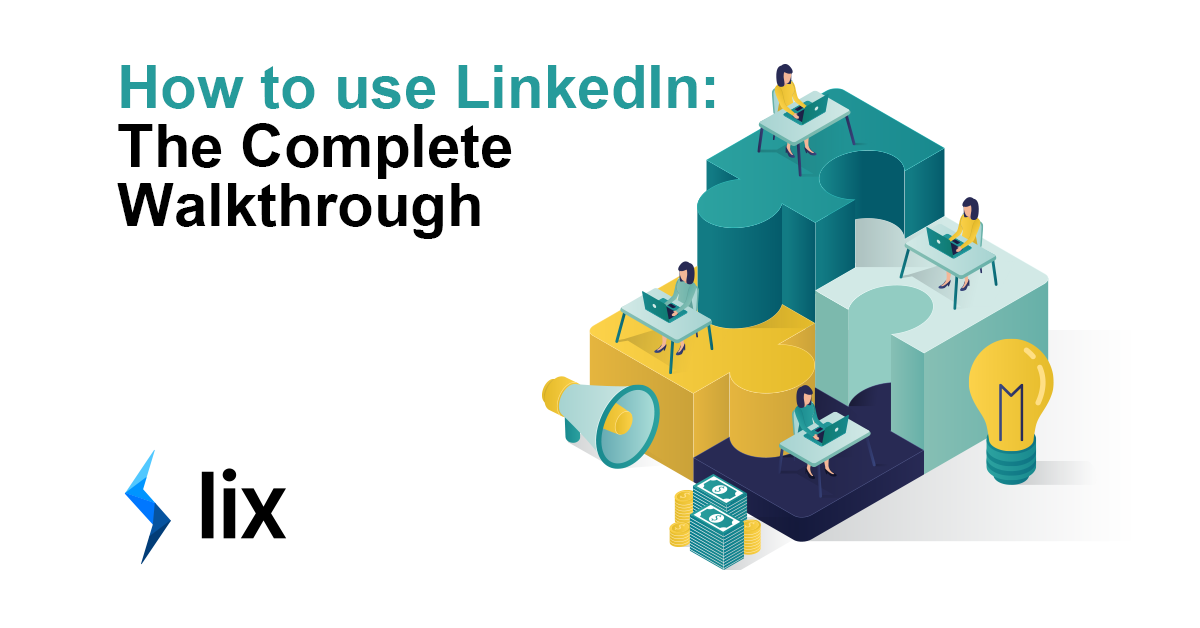Welcome to How to use LinkedIn – a complete walkthrough to help you master the professional social platform. This guide is split into four sections, one for each of the four pillars of LinkedIn mastery: profile building, networking & connections, content and company pages. Each section is accompanied by a video. Feel free to skip to the section you need help with most or read (and watch!) all the way through for the complete guide on how to use LinkedIn.
Profile
A strong profile is the very foundation of LinkedIn. Whether you’re using LinkedIn to look for a job, for networking or seeking potential clients you need to make sure that your profile is polished. A polished profile requires a quality avatar image, use of cover image space, tailored headlines, powerful descriptions and a focus on keywords.
In order to walk you through each section of the profile, we’re going to use my personal LinkedIn as an example (you can also watch this section’s *video* and follow along there).
When you sign into LinkedIn, you’re going to see something like this:

This is the LinkedIn feed. It’s where you see your connections (and sometimes the connections of your connections!) and their content: the information that they’ve posted, articles, video etc. This is where your content is going to show up when you post it. If you’re already au fait with LinkedIn, then you’ll know all about this. If you’re new to LinkedIn, take some time to get familiar to this view. The feed setup is very similar to other web-based social platforms such as Facebook, so it shouldn’t take too long to get used to.
Let’s jump right into my profile, which looks like this:

I’m going to take you each of the individual sections and explain how and why I’ve structured mine in the way that I have.
Profile Image
First and foremost, make sure that your photograph is professional. Not professional in the sense that a pro photographer took the snap (although that would be nice) but professional in the sense that you are projecting an image of yourself in a professional setting. No photos of you drinking, or smoking, or on the beach, or a party… This may seem obvious, but I see profile images like this fairly regularly and it is not a good look. You might think it makes you look cool and ‘out there’, but this is a professional networking platform, not a frat party.
My tip for presenting yourself professionally is to wear the clothes that you would normally wear to a networking event within your industry. If you’re in an industry that would wear black tie, or at least a tie and jacket, to a networking event then make sure you’re wearing something like that in your avatar. Remember, that’s what we’re using LinkedIn for. We are here to network in one way or another: finding a job, growing your network, looking for clients etc.
The avatar I use is a little more casual, because I work in startups and tech. I can have an open shirt with t shirt underneath, and that’s absolutely fine. Make a judgement call here. If you’re in doubt, opt for the smarter choice.
Cover Image
The cover image is something that a lot of people neglect, which is a real waste of valuable digital real estate! It doesn’t have to be an all-singing, all-dancing advertisement I’ve seen some that pack in way too much text) and you don’t need to sell something here, but don’t waste the space.
I’ve used something light-hearted and design focused for my cover image:
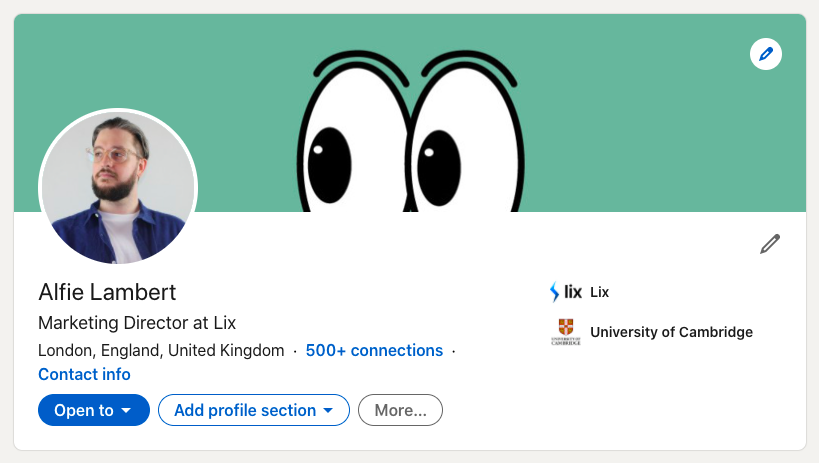
While it looks great, I can probably do a little bit better by making use of that space and saying something about the company that I work for, a launch we have coming up or perhaps some content we have to give away. If you’re looking for a job, you could always include something about your skills or your search here. If you feel like you have nothing to say in the cover image, don’t fret, include your company logo or a photo from a business event. Something is always better than nothing.
Here are some great examples of LinkedIn covers to give you some inspiration: https://bit.ly/LinkedIn-Cover-Examples
Another important point to consider is the recommended sizes for both the profile and the cover image; pixelated images simply will not do.
You can find a full guide to the sizes on Canva: https://www.canva.com/sizes/linkedin/
Canva is also a great tool for creating graphics easily. Follow the link, pick a size and start creating. clean and keep it looking good.
Summary & About
The summary section sits just below your images and includes your current job title, highest level of education, company and number of connections. This information is automatically populated from the details you enter in the relevant sections of your profile.
Here is my ‘About’ section:

You may have noticed a recurring theme with my about section and cover image – I’ve opted for style over substance! I’ve kept it lighthearted, but you can of course be much more serious than I have.
I’ve chosen three very simple, but I think fairly useful, points:
Firstly, an achievement: ‘Top 100 Growth Hackers’. I was voted as such in a study by Goodman Lantern. That’s an achievement, it sets me apart from my peers.
Secondly, expertise: ‘Automation expert’. Tthat’s a little bit more about me as a marketer, my skillset and background.
Lastly, on-brand humour: ‘Fantastic hair’. It’s funny and lighthearted, very on-brand for me, and I do have fantastic hair.
I have seen plenty of variations for the About section, from one-liners to rambling essays. Personally, I would shy away from writing too much here. A big block of text is going to put off any potential readers. Let your profile cover the details of your work history!
Featured
This is your chance to add media to give a little extra flavor to your profile.
Here’s my Featured section:
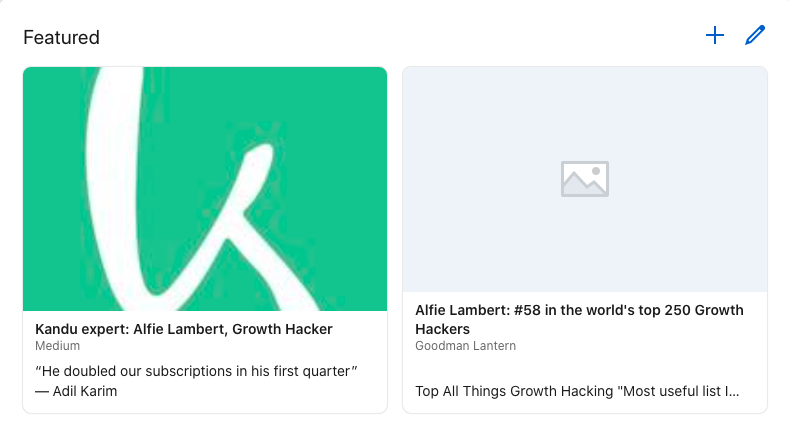
I’ve included an article written about me, talking about my skills and some of my achievements. This is really good: it shows that I have press coverage and that people are interested in what I do. If you have anything similar that celebrates your skills and achievement, be sure to include it!
The next along is my Goodman Lantern ‘Top 100 Growth Hackers’ nomination. The broken image on the link is a great example of why it’s important to regularly check your profile for changes. A broken image doesn’t fit with the rest of my profile, so I need to either replace it with something else or I need to speak to Goodman Lantern and get them to fix their metadata. Either way, I can’t leave a broken link on my profile!
There are other things you can do with this media space, in fact the possibilities are limitless. You can make a video CV where you talk about yourself, you can give a presentation on a project you’ve worked on, or something you’re interested in. This link space is an opportunity really show off who you are and what you’ve achieved.
Activity
The activity section is fairly important, although many people forget that it’s there. Let me explain why it’s worth bearing in mind…

Any engagements you make on the LinkedIn platform will show up here. Articles, shares, comments… everything! For content shares, that’s no problem – it’s great to have a second chance for people to find your content on your profile. Comments however can sometimes be an issue.
In the last few years, LinkedIn has become slightly more like Facebook in the sense that people will share personal and political things on the platform. That didn’t used to happen so much on LinkedIn, but it happens a lot now. Always remember, before you comment on something potentially controversial, those comments are going to show up on the activity card on your profile. You don’t want to have an argument with someone about their stance on Trump, for example, and then someone potentially offering you a job or a contract comes onto your platform, sees that you are saying things that they would find potentially unsavory and withdraws the offer. Trust me, it happens!
Experience
The most important portion of your LinkedIn profile. Here’s where you’re going to add your job titles, descriptions, the time that you worked there and any supporting media.

If you want to be found in the LinkedIn search, keep your job titles keyword friendly. Some people decide to call themselves ‘lead-gen startup guru ninja’ and while that may feel exciting, people aren’t searching for those terms. If you don’t use keyword-focused titles, you will appear in less searches, have less connections and less opportunities offered to you. If you’re not worried about those things and your primary concern is being cool and wacky, then go for it.
My most recent experience shows that my position is the Marketing Director for Lix and how long I’ve been here. In the description I talk a little bit about what the company does, but I don’t talk much about what I do in the company. That’s a personal choice and you can change that depending on what you’re hoping to get from LinkedIn. I’m not looking to be recruited (I’m in Lix for the long haul!) but if you are looking for a new job, use that experience section to talk about things that you’ve achieved and your responsibilities.
You don’t need to write too much: four or five sentences is more than enough. Think about the length of a tweet, rather than an essay. Blocks off text will put people off and they’re just not going to bother reading it.
Make sure that you are honest and accurate in these dates. If you’re looking for work, ensure that the dates here match up with the dates on your CV. It’s very important, because if a recruiter checks both and you’re telling fibs, then that’s not going to look good for you overall!
Education
Time to show off those grades and extracurricular activities!
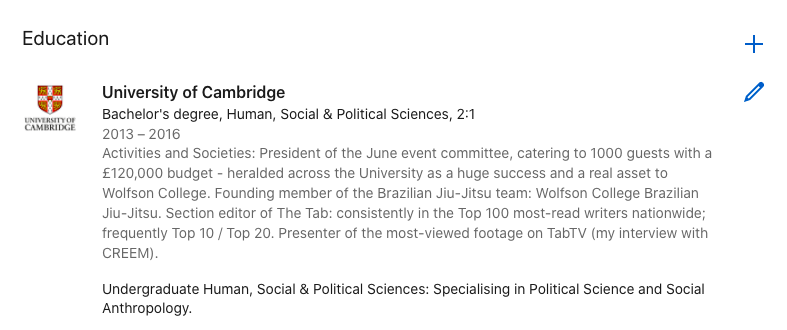
You can also include formal professional qualifications if you have any, in addition to the standard school and university stuff. If you completed an extra course, or you went to a night school, completed a MOOC or anything along those lines, you can include it there. This information will be pulled through to the top of your profile remember – the summary section shows your most recent role, current role and your highest level of education, so don’t forget to input that info.
Also, if you did anything extra while you were studying – extracurricular activities, societies, events – include it here. For example, I ran an event while I was at my university, founded a sports team and wrote for the student newspaper. Include this extra points, it all adds up.
Skills and Endorsements
Personally, I don’t think LinkedIn skills are particularly important anymore, but it can be quite a nice thing to trade endorsements with people that you’ve worked with or people you know. I don’t think that employers, or people that you network with, look at this often. Don’t get too het up about your skill scores.
Recommendations
Recommendations, however, are important. You can get recommendations from people that you’ve worked with, or worked for, or have worked for you. It’s a really good way of building up a picture of who you are as a person when you are working.

It’s all well and good saying, “hey, I did this job and I was great at it“, but if you can get your boss, or a colleague, or someone that worked for you to say, “actually, this person was great and it was a real pleasure to work with them and they’re a nice person, they’re great achieving goals or they’re good at this or that”, that is going to stand out and mean a lot more to someone viewing your profile than just you saying it yourself. It’s social proof, it’s like a testimonial or a review on an Amazon product. We all want to see that someone else has enjoyed this product, this product today being me, or you on your profile.
The great thing about recommendations is they’re really easy to get because you can give one and then ask for one in return. You can follow the ‘ask for recommendation’ button and pick someone on your connections list. Write one for them and then message them to to say, “hey, I’ve written a recommendation for you, please write one for me“.
Accomplishments
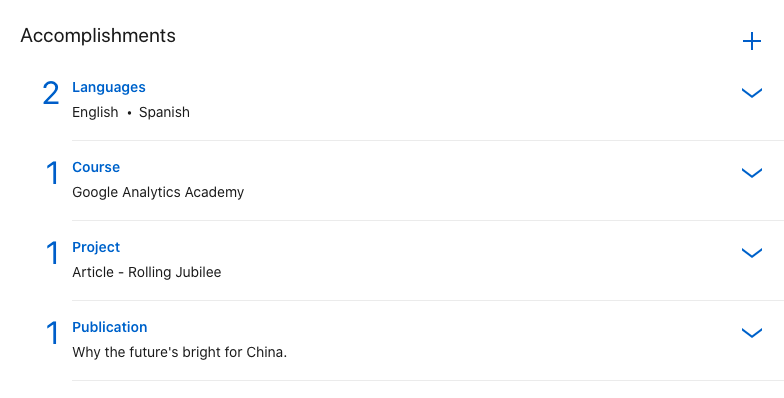
Accomplishments are just that – accomplishments! It’s another chance to strut your stuff. Speak more than once language? Include it here. You can also link to media, qualifications and any articles and videos you didn’t include further up the page. This section is much like the extracurricular activities that you would put on your CV.
This is also a chance to show that you’re really engaged with your industry. If you work in a highly competitive field, it can be really good here to show off the things that help you stand out from the crow. If, for example, lots of people are going to apply for the law firm you want to work for and you’ve been writing a blog, or you’ve contributed to a legal magazine – talk about it!
Interests
Similarly to skills, I don’t think people look at interests too much but you can try to ensure that your interests align your personal brand.
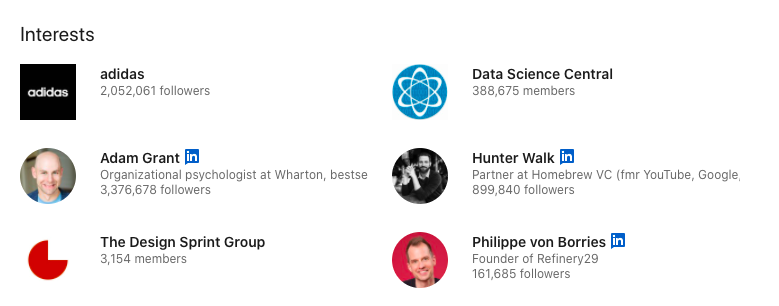
Whenever you follow a person, or company, it will be shown here.
URL & Public Profile
Your public profile is what people see when they come across your profile, but they’re not a LinkedIn member – usually from a Google search or similar. It’s similar to a private profile on Instagram or Facebook. LinkedIn gives you the options to choose what is visible here, so if privacy is a concern for you then be sure to check it out.
You may also edit your personal URL, making it easier to find you and giving you a cleaner link to post when you share your profile. For example, mine is linkedin.com/in/alfie-lambert – if you’ve got a popular name, go and claim your ideal URL before someone else does!
That’s all for the profile. If you’d like to follow along with the video, you can do that here:
Connections and Networking
This section of the guide explains the best way to find people, how to use the LinkedIn search, connecting with people, 1st 2nd and 3rd degree connections and then personalized connection messages.
Once your profile is complete, polished and ready for action it’s time to delve into connections and networking and there has never been a better time to network on LinkedIn. In fact, LinkedIn saw a 55% increase in conversations between connections in 2020. That’s largely because of the pandemic – we can’t go out and network in the ways that we used to. In 2021 if you want to connect in a professional setting, LinkedIn is the very best place to do that.
Let me hit you with some more stats: at the time of writing there are 720m users on LinkedIn and counting. It will probably hit a billion in 2021, if not 2022. If there’s someone in business that you need to talk to, or you want to get in front of, they’re probably already on LinkedIn.
Incoming Connection Requests
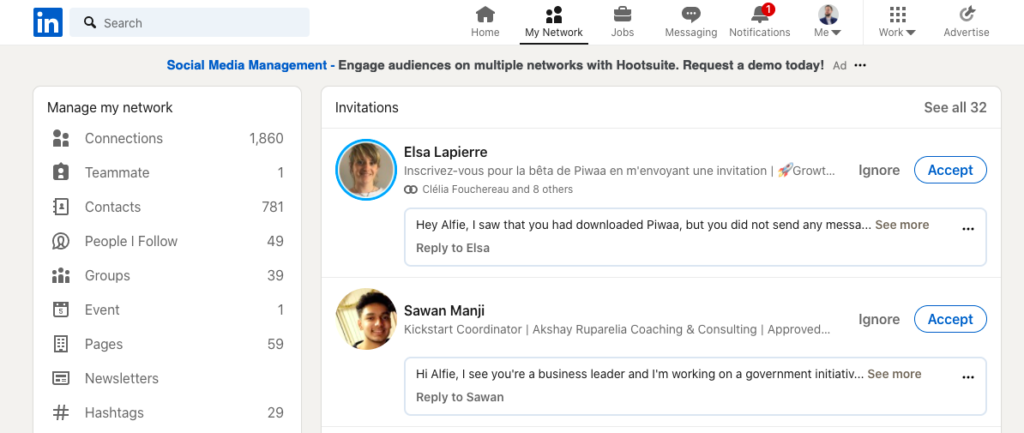
The first thing you will see when clicking on ‘my network’ on the top menu, are the people who have invited you to connect. You’ll notice that many of these connection requests, especially those from people you don’t know, will come with personalized messages (something we will cover a little further along in this blog).
The number of incoming requests you will receive should increase over time and with regular use. If you’re engaging with content, networking and so on it will attract people to your profile. Job title makes a difference here too. I’m listed as a Marketing Director, which means everybody wants to sell me products, or staff, or event tickets… As you can see, I have 32 pending invites and almost all of them are trying to pitch me something!
Some people preach caution when accepting connection requests. Perhaps if you’re a decision maker at a company and you really don’t like being pitched to, then yes be selective. My policy is the more the merrier; the bigger my network, the more people that see my content in the feed and potentially engage with it.
Suggested Events
Just below your incoming connection requests are some suggested (currently online) events.
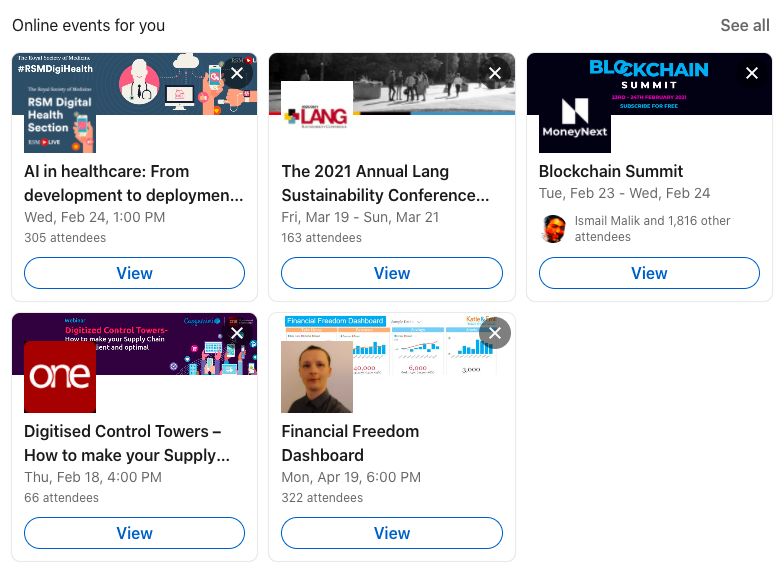
These events offer two benefits. The knowledge shared at the event itself, but also the opportunity to network. Attending events with people in your industry or with common interests can be a great chance to meet and connect with like-minded individuals.
This is true for all events, not just those suggested to you! Seek out events using the LinkedIn search function – search for your chosen topic, click the ‘events’ tab and get scrolling.
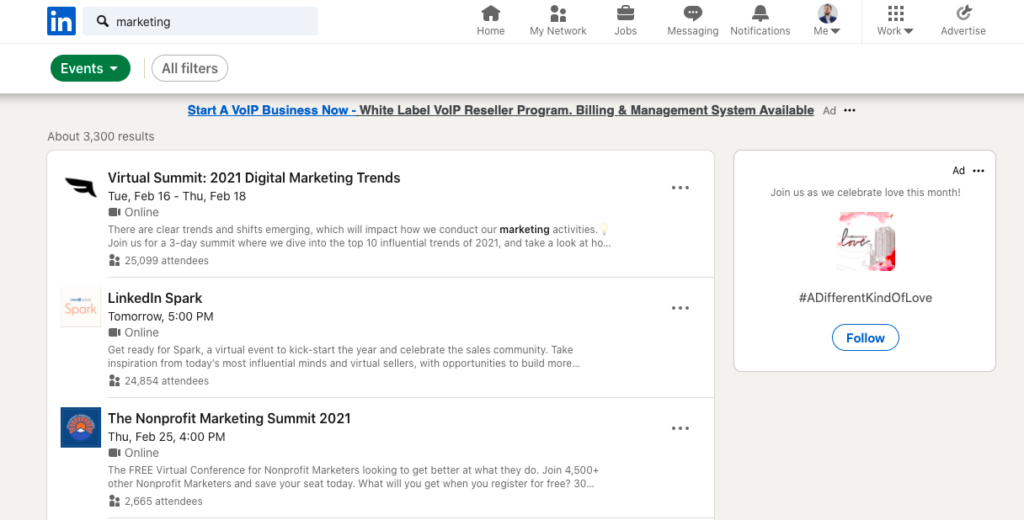
If you really want to maximise the event-based networking effect, host your own event! LinkedIn has a great onboarding guide to help you get started.
People you may know
Again, this is a really easy way to find people to connect with, people who might be working in the same industry as you. The LinkedIn algorithm is going to be piecing this together and they’re normally pretty good.
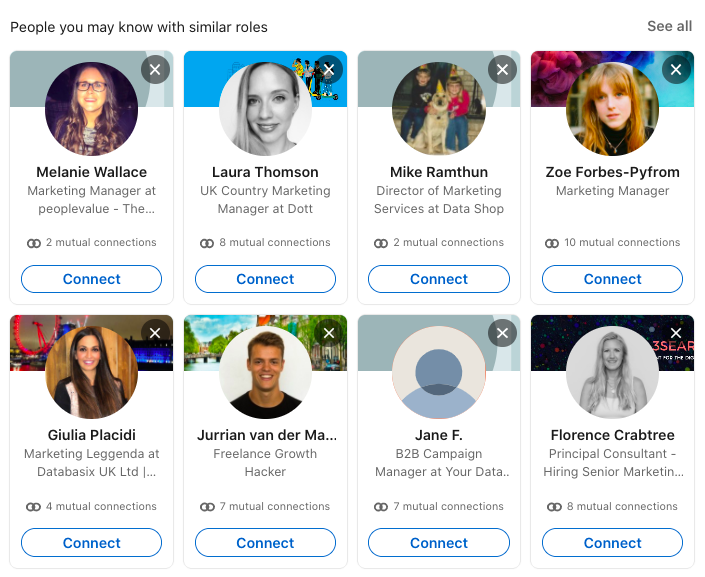
Connecting with other like-minded people in your field can be really useful for a variety of reasons. It’s particularly good for staying on top of industry news – if your connections are predominately people in your field, the content they share should be mostly relevant. This gives you even more opportunity to engage and build your network.
Networking
The easiest way to network with people within your industry is either following the suggested connections, but it can be a little bit impersonal. What is the icebreaker for people on this list? I like to give a little bit more than the standard “I’d like to connect”, especially if it’s a relationship that I want to nurture. A great way to offer more when connecting is to reference a shared interest, engagement or something the person has posted.
This is where LinkedIn groups can provide some great leverage. Head up into your search bar and search for relevant terms, for example I want to search for ‘marketing’, because that is the industry that I am in and want to network within. With your search term in place, head to the ‘groups’ tab.
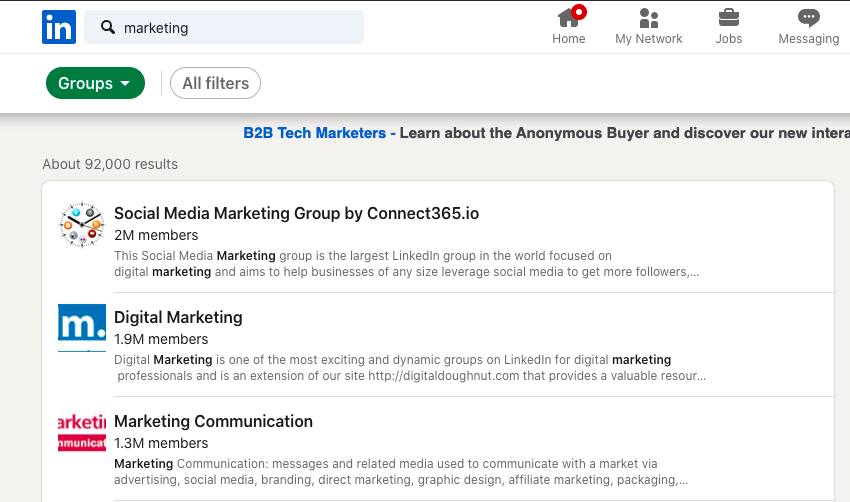
LinkedIn will suggest the largest groups related to my search term ‘marketing’. If the suggested groups are too general, use a longer search and some filters to find the group that fits your goals.
Once you’re in a group you can leave comments, engage with people’s topics or you can connect with them, using their comments and engagements as an icebreaker.
If I’m in the Connect social media group and I stumble across this post:
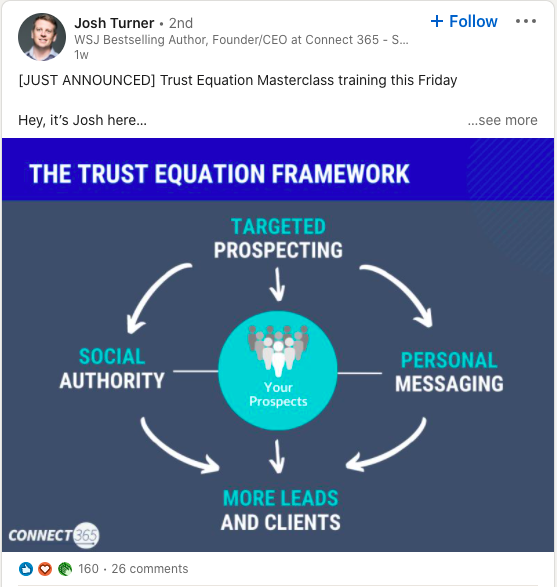
Perhaps I could connect with Josh Turner and say something like, “Hey Josh, I saw your post in the social media marketing group about the trust equation framework. I think that was really interesting. I’d love to connect“. This is going to give you a much better chance of getting that connection than just the generic, “hey, I’d like to connect” or even “hey, we’re in the same industry. I’d like to connect.”
Targeted Search
Sometimes stumbling across connections in groups and at events doesn’t cut it. Perhaps you want to meet CEOs because you’re a salesperson, or maybe you want to network with investors because you’re a startup and you want to get investment. When you have a specific target in mind, you can use the powerful LinkedIn search.
(We’ve written the ultimate guide to the LinkedIn search for more details on this!)
As an example, for us to follow along, let’s say I want to find someone to teach me more about marketing; someone who’s perhaps at a higher level than I am, I might search for the job title CMO (Chief Marketing Officer).
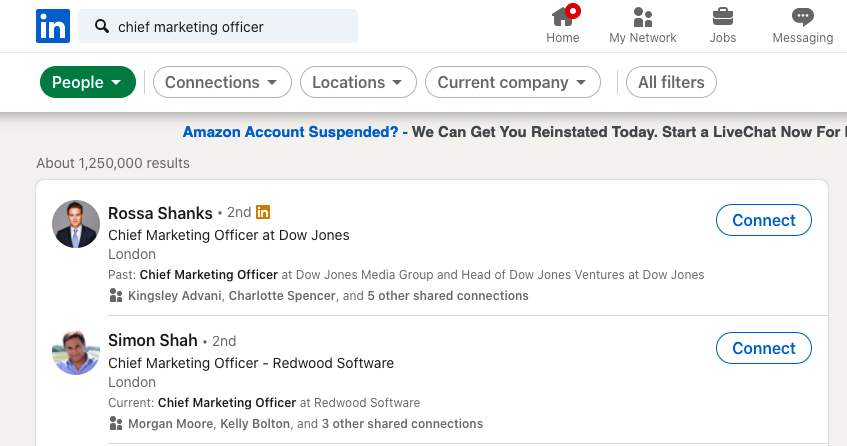
LinkedIn returns 1,250,000 results, wow! Obviously, that’s a few too many to sift through, so how can I filter them out? I can head to the connections tab and choose which degree of connections to show (more on this below). I’ll opt for 2nd degree connections – the connections of my connections – so that I have some kind of link to the people it displays.
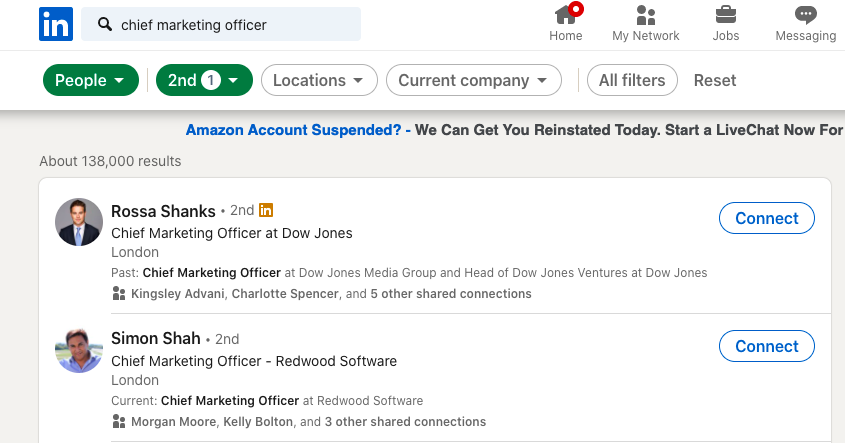
I have 138,000 possible results. Perhaps that’s a little too broad. From here I could filter by location, current company or a host of other filters in the ‘all filters’ tab. Location isn’t so important to me, as everyone is working remotely these days anyway.
Let’s filter by current company. The top suggestion is Google – perfect.
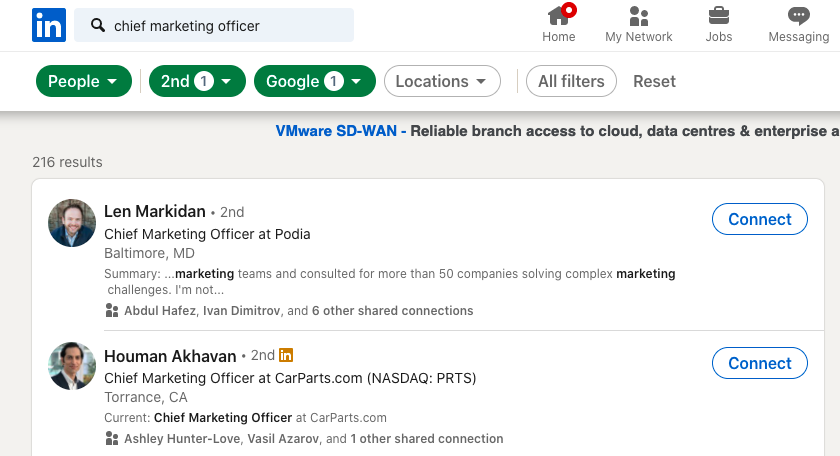
That brings my number down to 216 results. Of course, not all of them are the CMO for Google (the CMO of Google is Lorraine Twohill) but they are people who are or have been CMOs, that currently or previously worked for Google.
The top hit from the results is Len Markidan, CMO for the online course provider Podia. He seems like the kind of person I’d like to network with and have in my feed. Let’s use Len as an example for the next section.
Personalized Connection Requests
As mentioned earlier, ideally you will have some kind of icebreaker when connecting with someone you don’t know. Let’s see if I can find an icebreaker for Len.
I have a few mutual connections with Len, but not any that I know well enough to use as an intro to a conversation. I’m not in any common groups with Len, so I’m going to take a look at Len’s activity to see if there’s any common ground I can find there.
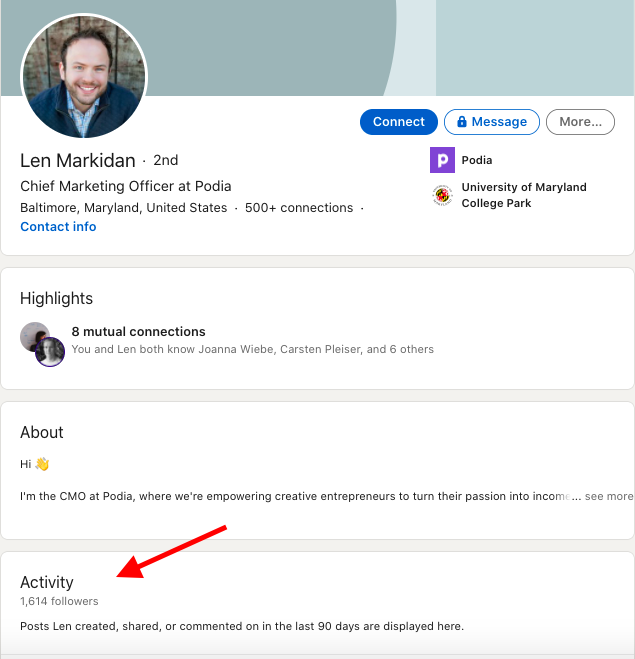
My search of Len’s activity shows two things – firstly, he hasn’t posted on LinkedIn since 2018. If I was really interested in networking, I probably wouldn’t connect with Len knowing this, I’d prefer someone more active.
For the sake of this example though, let’s take a look at the content Len posted:
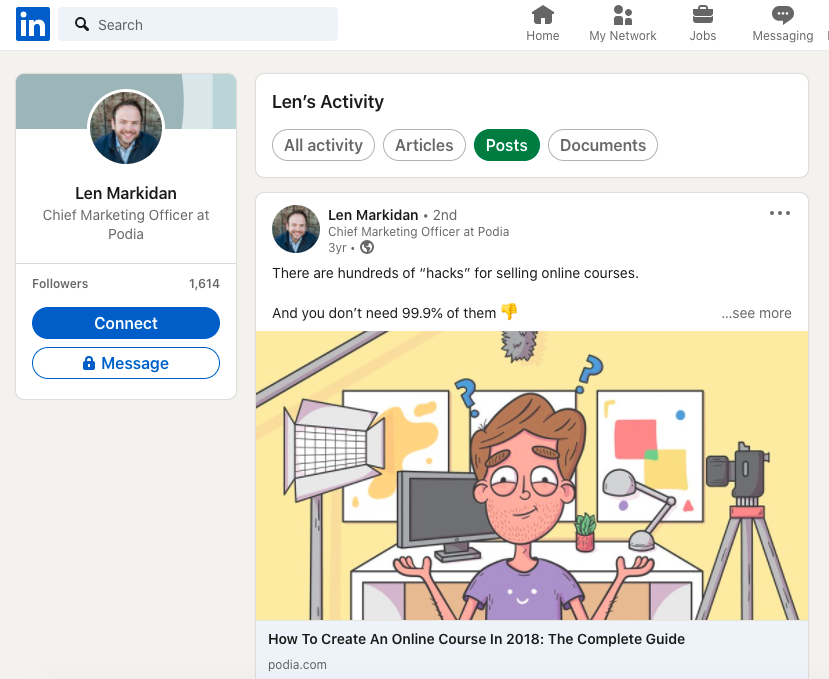
This post from Len’s company, Podia, is a perfect icebreaker for my connection request. I can reference the post in my personalized message; hopefully cutting through all the generic connection requests and sales pitches.
I advise keeping the messages short and sweet, firstly because there is a character limit and secondly because the preview only shows a few words along with your request, so you need to hook them in early on. For Len, I could say something like:
“Hi Len, I read your post about creating online courses and found it really interesting, would love to connect”
Even with the cut-off, Len will see “Hi Len, I read your post…” and that might be all I need to stand out from the sea of generic requests.
Looking for more tips on connection request messages? Sumo have a great guide here.
1st 2nd and 3rd Degree Connections
You may have noticed while browsing of LinkedIn that you have 1st degree connections, 2nd degree connections and 3rd degree connections.
Your 1st degree connections are people that you are already connected with. Your 2nd degree connections are people who are connected to your connections. Your 3rd degree connections are people who are connected to your 2nd degree connections. Anyone outside of that is outside of your network, in which case you may not be able to connect with them, depending on their privacy settings. If you land on someone’s profile and they are outside your network and their profiles displays a single name (first name or surname), that usually means that they are not open to connections from people outside of their network.
By now, you’ve got a great profile and you’re starting to make some connections, that network is really going to serve you well in the future. To take it to the next level, we need to throw some content into the mix.
Content
The amount of LinkedIn native content produced increased by 60% in 2020 – for the same reasons that conversations did. With lockdowns, closed offices and home working on the rise, people are absorbing more content on LinkedIn than they ever were before. There has never been a better time to start producing content native to the LinkedIn platform.
You can use content to build a reputation as an expert in your field, looking for jobs or land clients; whatever it is that you’re on LinkedIn to do. This section will talk you through some best practices for content creation, plus how to work with the LinkedIn algorithm to get the most engagement so that you can become a content creating master.
LinkedIn Posts
The most common type of content on LinkedIn is the humble post, here’s a recent one I shared:
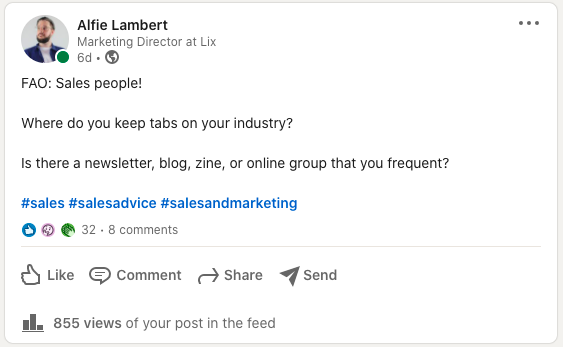
As you can see, I’ve added hashtags here to help get my post in front of the right audience. These are especially useful if your post begins to get engagement, because LinkedIn will show well-engaged posts to people that follow those hashtags.
There a few things I could have done to boost this post further, however. LinkedIn stats show that posts that contain images get twice as much engagement. So, if you can include an image to support your post then do so!
From the ‘start a post box’ you can choose where your post will be seen. If you have a company page, which (our next guide section!) you can share from the company page. You can decide whether your post is going to be public, connections only or specific group members. You can share straight to your Twitter, too.
Simple posts are the tip of the iceberg. From this view, there are a number of options:
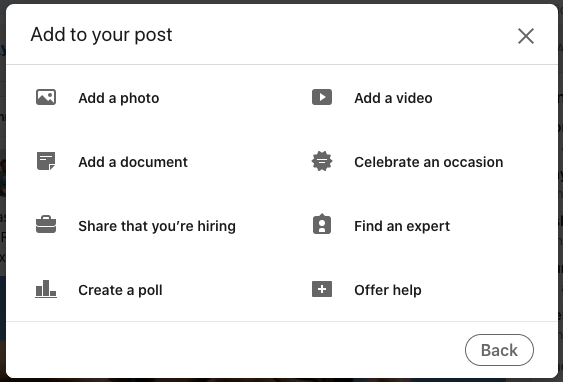
You can link to a document, create a poll, share that you’re hiring, celebrate an occasion, find an expert, offer help… there is so much that you can do just within this framework.
Articles
The most common type of long form content on LinkedIn is the written article. You can access this screen from the same section as posts, just click on ‘write an article’:
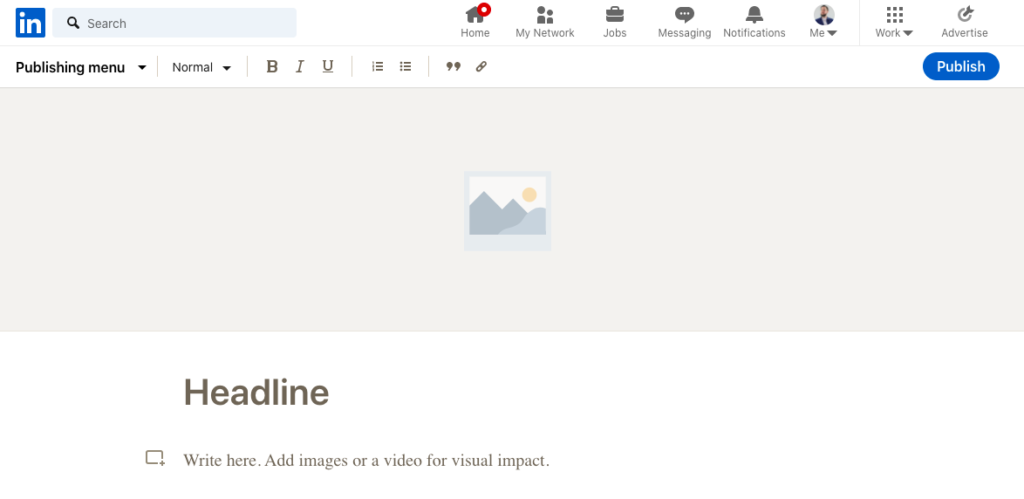
First thing you will notice is the huge space for an image at the top. Some people are still posting articles without header images which to me, is crazy. Once again, it’s valuable real digital real estate – it’s also something readers expect to see. As any UX expert will tell you, delivering what someone expects is key to a smooth experience. People want an image here; the blank space is jarring.
For a great guide to header sizes, design and the tool to create your own amazing images, head to Canva: https://www.canva.com/linkedin-banners/templates/
Let’s take a look at one of my blogs as an example:

The last article I published was back in July 2020 (I need to get writing!) and it is about marketers ‘fishing in the same pond’. Here you see, I have made an attractive and relevant cover, using the same background color that I have in the cover image on my profile, to give me a little bit of brand uniformity. Make sure that you also include line breaks and spacing within the blog, with a peppering of images to break up large blocks of text.
B2B blog writing guidelines: https://altitudemarketing.com/blog/how-to-write-b2b-blog-post/
Video
In the past I have been known to publish and write articles on LinkedIn, however in 2021 I would probably opt for video, rather than written content. The reason for that is, if you delve into LinkedIn stats, you will see that users are 20 times more likely to share a video than a written post. That 20x boost in shares is will make a huge difference to your engagement!
Now, I know some people aren’t comfortable with producing videos. I would say if you are nervous, just start making practice videos! The more you make, the more comfortable you get. I used to hate being in a video and now I’ve produced a 40-minute video guide to using LinkedIn. It just takes practice.
A great thing you can do with video to increase its reach is use a transcription service, something like trint, that allows you to add subtitles to your footage. People use LinkedIn primarily at work and perhaps they can’t use speakers or headphones, so if you can include some subtitles, you’re going to get many more engagements. I don’t have official figures to give you, but I normally find I can add about 50% to my engagement just by using subtitles alone.
LinkedIn Live
There are some new forms of content production available on LinkedIn that people aren’t really maximizing at the moment – LinkedIn live being one of them! Despite the slow uptake, live streams on LinkedIn have increased bt 437% in the last year. It’s slowly becoming a big part of the platform and as with almost any social media, even professional social media platforms, they will promote their newest baby to its fullest extent.
For instance, Instagram has recently launched reels to compete with TikTok. An Instagram reel is going to get more engagement than a standard Instagram post, because Instagram wants people to use reels, so they will encourage it and promote it. They had the same boost with IGTV about a year or two ago. IGTV videos were getting much more engagement because Instagram was showing them more in the feed, because it wants more people to use IGTV. It is the same thing with LinkedIn. They want people to be using the live video and just video in general.
Algorithm & Engagement
LinkedIn’s feed runs on an engagement-based algorithm. The more people who engage with your posts, the more people who will be shown your posts… and then the more people who will engage with your posts… It’s a self-fulfilling cycle! This is another reason to have a good and lots of connections, because the more people that see your posts in the feed, the more likely is that they’re going to engage with it – especially if they’re relevant. If they work in the same industry, maybe they’re interested in the same topics and then when they engage and comment on your posts, people in their network will see in their feed that’s happened and then they will come into contact with your with your content. This is a really important point to consider if you want to post content on LinkedIn.
Also think about the time of day that people are on LinkedIn and engaging with content. If you post something at 11am, perhaps everybody’s busy working. Maybe 8am / 8.30am just before people start, when they’re on the way in, or lunchtime, or maybe just after work when people have the time to be browsing. Post content when more of your audience is engaged with the platform.
Company Pages
Now have a great profile, loads of connections and you’ve started putting out some content on LinkedIn: the next step is a company page. LinkedIn company pages aren’t just for big businesses. If you’re a small business or even a freelancer, you could set up a LinkedIn company page to showcase your work in a more professional setting. If you’re an employee and your company has a LinkedIn company page, make sure that you’re connected to it. If they don’t, maybe you can earn some brownie points with your boss by creating one..
I’m going to show you two examples of company pages, one that is better than the other. The better page is for Teleperformance. They were the number one LinkedIn company page in 2019 as voted by LinkedIn members. The other that isn’t so good is my company page for Lix, because I need spend a bit more time on it! I’m going to jump right in with Lix and I will show you some of the things that I’m missing and then we’re going to look at Teleperformance to show you why they are so good and why they are the example that you should be following for your company page.
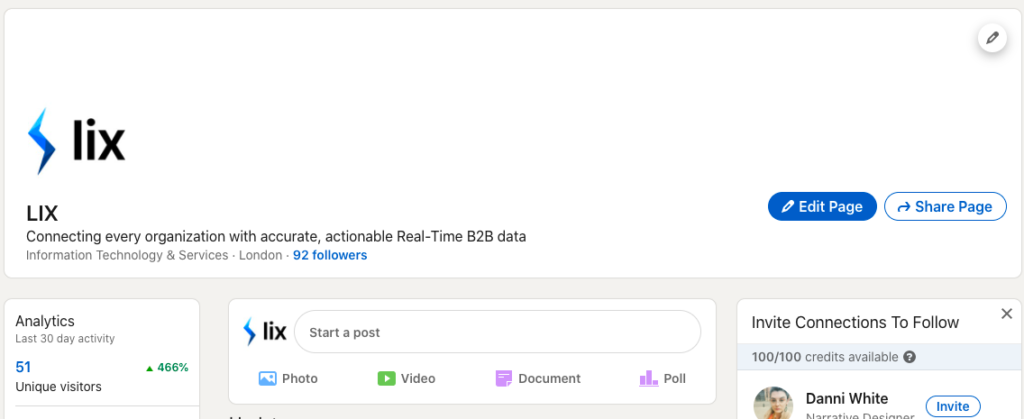
We only have 91 followers at the moment, but that’s something that we can work on by sharing a bit more content. In the content section we looked at the share box in the feed, and you can use it the same way here: start a post, share a photo, share a video, documents, polls and all that good stuff. Creating good content as a business, especially stuff that gets re-shared, can bring in lots of good followers.
We have a fairly good tag line “Connecting every organization with accurate, actionable Real-Time B2B data”. That’s what we do! I have a longer description in the ‘about us’ section, which is a must. We have our logo on there, which is another absolute must.
The big glaring mistake is this cover image. We are not using this space at all. Now, I do have a good excuse for that – we’re in the middle of a massive rebrand and we’re going to be producing lots of great new graphics etc. that branding is going to be added as soon as it is there, but for now, it’s just a big white space, which is not ideal.
Let’s take a look at the Teleperformance page and explore why they do it so well and how you can use these tactics for your company page.
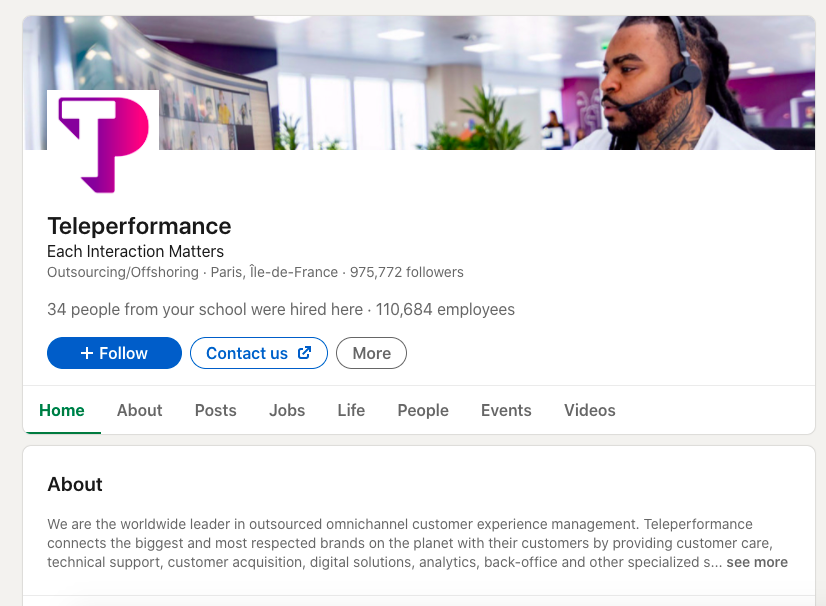
Teleperformance are a worldwide leader in outsourced omni channel customer experience management… If that doesn’t mean anything to you, don’t worry too much! That’s not the point of why we’re here. We’re here to see what components make up this great page.
One thing we notice right off the bat is this cover image with a member of their staff. Within this image, they’ve spoken quite a lot about the ethos of their company. Their member of staff quite visibly has quite a big tattoo on his neck: he’s quite a cool-looking, well groomed and presented. This isn’t by accident, this image is there to make you think “Hey, these are a young, cool, exciting organization” that speaks to their ethos, to their brand. If that’s not your brand then this isn’t the way for you to go, but something along those lines could really work well, something that shows in a nutshell what you are all about. Their tagline is, “each interaction matters” which I quite like. Short, sweet, to the point and again, it speaks to that brand.
Teleperformance have nearly a million followers and 108,000 employees – there are a big company with lots of followers. What’s quite interesting to note is that they have 10 times the number of followers to employees, which means that the people following them aren’t just their employees. It shows there are lots of people out there who are really interested in what Teleperformance have to say.
Their ‘about’ section has plenty of detail, which explains who they are and what they do:

It gives you an overview of the company, their website, what industry they’re in, how many employees they have, where they are, when they were founded and what their specialties are. Now, all of this information you can add to your own company page quite easily, just by hitting the edit button (the little pencil icon) when you’re signed into your own company page as an admin.
They have a link to their location, showing that they are right in the middle of Paris – a lovely place to work! You can go through and look at their ‘posts’, which you can filter images, documents, videos or ads.
The ‘jobs’ tab allows you to look at any jobs posted by Teleperformance. ‘Life’ is an interesting one and not a lot of people use this tab, but this is about the lifestyle of Teleperformance and their staff:

As Teleperformance are a large company, they’re showing off the company culture and other lures around hiring, because they’re committed to attracting the best talent. This is adding a bit more flavor to Teleperformance, who they are and what they do – this isn’t just a dry description of a company and a business. It’s important to note that this is a paid feature, acquired via LinkedIn’s Career Pages – get in touch with them for pricing.
This section demonstrates their commitment to an ethos and a way of living. You can look at the pictures and say, “hey, what a great place to work”. They’ve got bean bags and hammocks and ping pong tables… Maybe this is the kind of company that you would like to be part of.
Congratulations, you have completed the How to use LinkedIn complete guide – you’re an allstar, with a ton of connections, high-flying content and a polished company page. Now get out there and achieve your LinkedIn goals!
